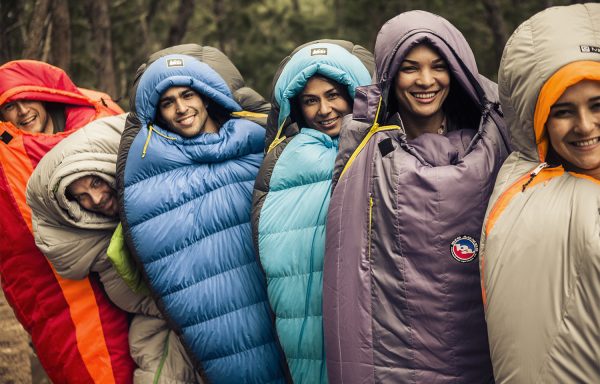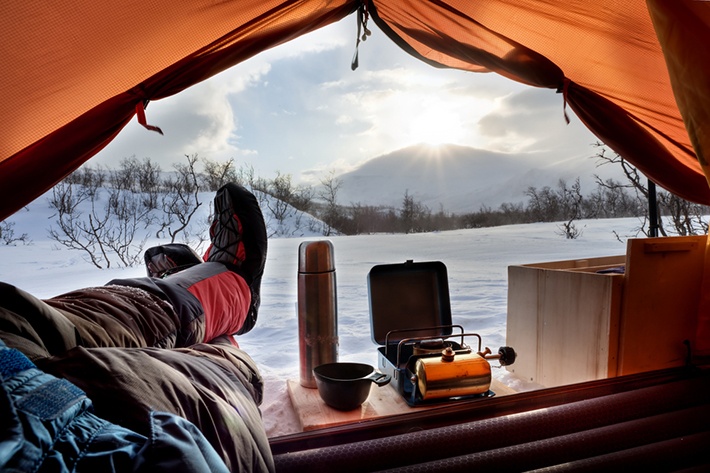Polyester is one of, or even the most used materials for clothing today. It’s an affordable material that is great for mass production of clothing elements, bags, shoes and even some tents.
A lot of people are wondering is it retaining the warmth and should they buy items that are made of polyester.
The general opinion is that you should buy more expensive clothing which is stuffed with down, but that’s a much more expensive option, and it’s not resistant to moisture.
So, I thought that it’s time for me to give my own input on the subject is polyester warm, and should you buy anything that is made of it.
More...
What Is Polyester?

Via rei.com
Well, basically it’s a fabric made of plastic. It has pretty good heat retaining properties, high wind stopping value and it’s a good insulator.
It’s very slim and can be made in different thicknesses.
It’s widely used for producing rain jackets, backpacks and sleeping bags due to its water resistance.
Polyester is a fabric that can wick away moisture while keeping you warm and safe from the wind.
People are mostly choosing between down and polyester, and while down can make you much warmer, it can be a problem when moist.
There are no such problems with polyester, the only thing it lacks is the lightweight and thinness.
Clothing Made of Polyester
Polyester is found in winter and summer collections of clothing. Since polyester dries off quickly and it doesn’t retain moisture, it has to be combined with other materials like cotton for summer pieces of clothing.
While the clothing made of polyester don’t have some advanced properties like breathability, it can retain the heat pretty good, and the pieces of clothing made of polyester can be the great winter protection.
The best pieces of clothing for winter and to keep you warm, are the ones that are made of a combination of polyester and wool or cotton.
Wool and cotton contribute to comfort and to raise the temperature of the body, while polyester keeps it from escaping.
Polyester Outdoor Equipment
Polyester is used in many sleeping bags and pads. It’s usually combined with wool or cotton to raise the temperature around your body.
With this kind of combination you get the insulation and the warmth you need. Polyester is a very lightweight material, so combining it with other materials is always a good idea.
- Mummy-style adult sleeping bag designed for camping even in temperatures as low as 0 degrees Fahrenheit
- Can comfortably accommodate most people up to 6 feet 2 inches in height
- Semi-sculpted hood that tightens with a drawstring to seal in warmth
- Quilting construction, an insulated footbox, and a Thermolock draft tube for maximum warmth and heat retention
- The ZipPlow system prevents fabric from snagging during zipping
As long as that piece of equipment is keeping the heat in and it keeps the moisture out, it will satisfy your needs. And to do so, it requires a layer of polyester in it.
People think that companies use the polyester just because it’s cheap, and this is one of the reasons, but the end price is also lower, so you are not getting tricked if that’s what your concern is.
How Do Fabrics Made For Cold Weather Work?

The main concern and task that fabrics for cold environments should fulfill is retaining the warmth around the body.
They should not retain the moisture and should be dry all the time. The best example for these properties is, in fact, wool and polyester.
Wool is pretty resistant to water, and it can absorb the moisture of your skin and release it out in the dry air, drying your skin in the process.
Polyester is even more resistant to water, and that is why it’s widely used in outdoor equipment.
Polyesters are either tightly weaved or coated with chemicals to fight off the water. And cooling your body is just one of the problems that moisture can cause.
Cotton is not a good material for this purpose, due to its highly absorbent properties. It absorbs the moisture, and it holds it in, cooling your body instead of warming it.
So, the best choices are the materials which can dry quickly and are resistant to water, such as wool and polyester.
Of course, layering is very important, but it’s also important what do you make those layers off. The outer layer should be a rain shell, mid layer should be an insulator, and the base layer should be wicking the body moisture.
Related Posts:
Wool, Down or Polyester? Which Fabric is Best for Cold Weather?
All three options are great for insulation. Now, the problem occurs when they get wet, which one loses its insulating properties and which one does not.
Down completely collapses if it gets wet and it loses its insulation value.
Wool can get wet and get dry with the help of body heat. It makes the moisture evaporate, and it dries off on its own.
The same thing goes for polyester. The problem with moisture evaporation is that it requires heat, so wool and polyester will dry off, but at the expense of your body heat, making you feel colder.
Once they are dried off, they will be able to keep the warmth of your body from escaping again.
Should You Spend Your Money On Polyester?
People are skeptic about polyester because it’s very cheap and mass produced. There are some better and more expensive solutions, but polyester will do a good job, especially when combined with few other materials.
If it does the job and you can save the money, then there is no downside to it.
Sure you can go for the most expensive option, but you will do fine even with cheaper equipment with polyester too.
I should note that if you are a serious outdoors enthusiast, then you definitely should pick something more expensive, but if you go out camping just a few times a year, then I say, go for polyester.
Conclusion
Polyester is a good choice if you’re an occasional camper. You won’t freeze to death, and you won’t spend any unnecessary money.
For people who are more serious about backpacking and camping, I would recommend buying the equipment that is made of down.
And sure, even enthusiasts can get a piece of clothing made of polyester if they happen to be on a budget. It just won’t be the greatest solution for camping for longer periods of time.
Have you had any experience with polyester equipment or clothing? Is polyester warm enough for winter If so, please share your experiences with me.



I am 72 and living in ottawa. looking for a good jacket falling up to my thigh. 5.5” and 130 lbs. looking for a good jacket to wear in the spring autumn and winter. I Don’t
drive now and bus driver chauffer me around the city! Most of the time I wear my backpack and stuff in things I see on my usual errands. I saw a coat MICHAEL Michael Kors – Hooded Anorak DUFFLE and it is made of polyester. I have a lot of warm clothes to wear inside and thought it will be a good buy. My only concern is, the rain, or snow storm….how will it react to these elements? it become soggy and unattractive? Please advice me on this. Thank you very much!
I have worked in consruction in the U.K. in all weathers for years. I think fifty cents each way is the best bet. A wool and polyester mix. Also get in the habbit of losening clothing now and then. When you go in a heated shop or bus losen your scarfe and top Buttons. Do them Up just before going back out. Also hang jackets on a hanger when you take them off. Keeps them aired and fresh.